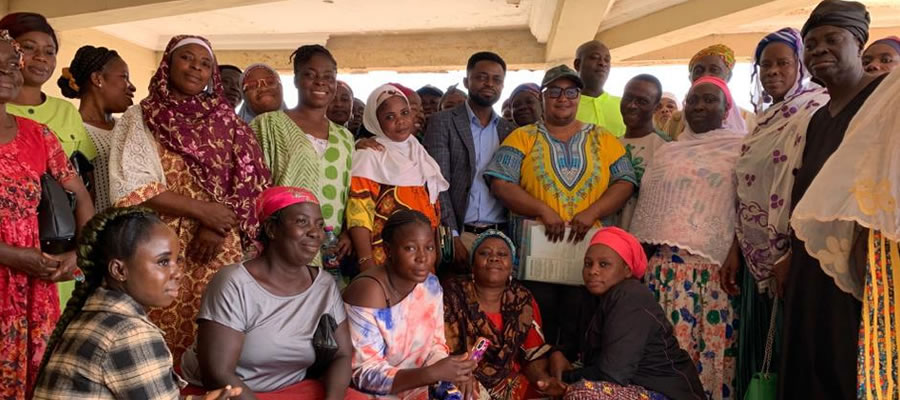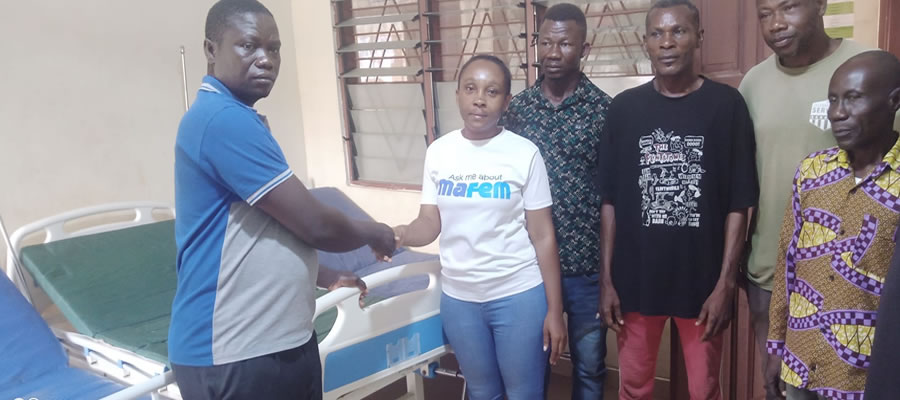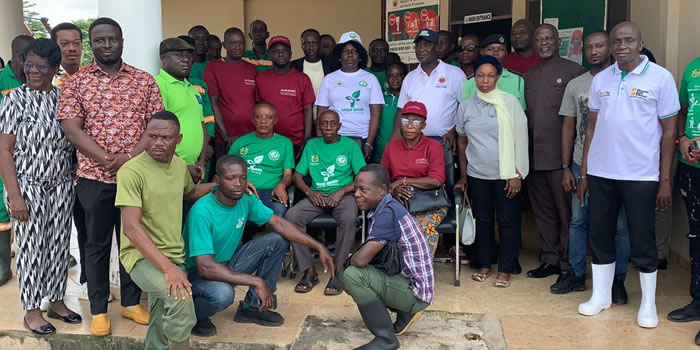

Development Projections
The main aim of the Atwima Mponua District Medium Term Development Plan 2006-2009 is to reduce poverty, increase employment opportunities and improve access to basic social, economic and technical infrastructure in order to improve the overall standard of living of the people in the District. The successful implementation of the outlined interventions depends very much on availability of resources, their efficient mobilization and use and most importantly commitment to the Plan’s implementation.
Choosing the programs that will lead to the expected future state of development of the Atwima Mponua District Assembly required a decision criterion which assessed the impact of various scenarios or paths. For the purpose of this plan, the under listed set of criteria was used to select a development scenario:
The ability to promote, sustain and consolidate previous and future growth,
Promotion of equity,
Enhancement of local participation in implementation and maintenance and use of local resources,
The project cost and
Conformity with government development policy.
From the analysis, the most suitable development path for the Atwima Mponua District Assembly is an ‘Integrated Development Scenario’ as it gives the needed attention to all sectors of the district economy and allows the District to pursue a co-coordinated program of social, technical and economic development as envisioned by the GPRS-II.
The Plan identifies key areas within the space economy for interventions/programs under the following themes of the Growth and Poverty Reduction Strategy Document (GPRS-11):
Private Sector Competitiveness
Human Resources Development and
Good Governance and Civic Responsibility.
Local Framework
For each Sub-Pillar of the GPRS -II, the goals and assumptions have been stated in the Project Planning Framework (Logical Frame work) below which also defines the objectives, verifiable indicators and the required interventions.
GPRS – II PILLAR: PRIVATE SECTOR COMPETITIVENESS
Sub-Pillar: Modernized Agriculture
Program Goal: Increased agricultural production through improved technology, access to credit and inputs and extension services.
Program Objectives:
To increase production of grains by 20% by December 31st, 2009.
To assist 4,500 farmers access credit and input by 30th December, 2009.
To assist 10,000 farmers adopt improved technologies by 31/12/09.
To increase agriculture production by 10% by 31/12/09.
Sub-Pillar: Support Service
Program Goal: Improving technical and economic infrastructure to support growth.
Program Objectives:
To facilitate set up of 9 Agro-processing facilities by 31/12/09
To facilitate cellular phone coverage by 31/12/07.
To construct 2 new markets by 31/12/09.
To rehabilitate 200km of feeder roads by 31/12/09.
To tar 50km of roads by 31/12/09.
Sub-Pillar: Development Of Additional Sector To Support Growth
Program Goal: Increasing economic opportunities through the diversification of agric production for job creation.
Program Objectives:
To facilitate the development of standard hospitality facility by 31st December, 2009.
To facilitate the exploitation of the bauxite deposits.
To promote the adoption of exotic plant farming.
Sub-Pillar: Employment Generation
Improvement and Expansion of Safety Nets.
Program Goal: To enhance household incomes through jobs.
Program Objectives:
To create 1,000 jobs by 31st December, 2008.
GPRS – II PILLAR: Human Resources Development
Sub-Pillar: Safe Water and Environmental Sanitation
Program Goal: Ensuring increased access to safe water, improved sanitation and environmental hygiene.
Program Objectives:
To increase safe water coverage from 41.8% in 2005 to 75% by 31st December, 2009.
To construct 4000 Household and 60 Institutional Latrines by December 31st, 2009.
To improve environmental sanitation in all communities by December 31st, 2009.
SUB-PILLAR: Education, Skills, Manpower And Sport Development
Programme Goal: Ensuring sustained improvement in the quality of life through enhanced access to basic services and facilities.
Programme Objectives:
To equip 300 youths with employable/entrepreneurial skills by June 30th, 2009.
To improve basic school enrollment from 73% in 2005 to 95% by December 31st, 2009.
To improve BECE pass rate from 36% in 2005 to 75% by December 31st, 2009.
To construct 12 new school blocks by 31st December, 2009.
To commence a phased development of a District Sports Stadium before 1st July, 2008
To construct of 6No. Teacher living quarters December 31st, 2009.
To half the 2005 number of untrained teacher in public schools by 31st December, 2009.
SUB-PILLAR: Population Management
Program Goal: To promote District Population Management.
Program Objectives:
To develop and implement a District Population Management Policy by 31st December, 2007.
SUB-PILLAR: urban Development, Housing And Slum Upgrading
Program Goal: Ensuring orderly infrastructure development within the built environment throughout the District.
Program Objectives:
To increase housing stock for workers by December 31st, 2009.
To prepare and implement planning scheme for Nyinahin by June 30th, 2007.
To prepare Layout for 4 major towns in the District by 31st December, 2008.
SUB-PILLAR: Access To Health Care, Malaria Control And Prevention Of HIV/AIDS
Program Goal: Ensuring sustained improvement in the quality of life through enhanced access to basic services and facilities.
Program Objective:
To half OPD reported cases of all preventable diseases by December 31st, 2009.
To equip the Kotokuom Health Centre before December 31st, 2007.
To construct 3 health facilities by December 31st, 2009.
To construct 6No. Living accommodation for Health workers before 31st December, 2009.
To reduce HIV/AIDS incidence rate of 3.5% in 2004 to 1.5% by 31st December, 2009.
To support 150 person affected by HIV/AIDS by December 31st, 2009.
To expand District Mutual Health Insurance Scheme coverage of 40% in 2005 to 95% by December 31st, 2009.
SUB-PILLAR: Social Policy Framework For Mainstreaming Vulnerability And Excluded
Program Goal: Ensured enhanced opportunities and safety nets for the vulnerable.
Program Objectives:
To increase build a data base on the vulnerable and persons with disability.
To abolish all denigrating traditions and norms in the District by December 31st, 2009.
Develop and implement a regular social policies/issues public education campaign strategy by 31st July, 2007.
To develop and implement enhanced safety net for all groups of vulnerable and excluded by 31st December, 2007.
GPRS-II PILLAR: Good Governance And Civic Responsibility
Program Goal: Enhancing local governance, civil society participation and safety.
Program Objectives:
To establish a Complaint Unit within the Assembly by December 2007.
To increase internally generated revenue from 60% in 2005 to 80% by December 2009.
To develop expenditure control and budget measures and implement them by December 31st, 2007
To prepare Revenue Improvement plan for the Assembly by 31thJuly, 2007
To make all 12 Area /Town Councils operational by December 31st, 2008
To institutionalize bi-annual Management /Communities’ Meet the people Assemblies/Forums by 30th June, 2007
To establish a Police Post at Mpastia by December 31st, 2008
To establish community policing Teams in 6 selected towns by March 31st 2007
To empower 100 women to participate in local governance at all levels by December 31st, 2009
To attract and retain needed qualified key staff by December 31st, 2009
To enforce the law on Assembly Members/Electorate forum by June 30th, 2007
To attract high quality staff to head Departments of the Assembly by December 31st, 2009
To conduct 2No. Capacity enhancement training for Assembly members and members of all sub-structures before June 30th, 2008.
Development Goals and Focus
Development Proposals
In formulating the development focus, goals, themes, scenarios and the development framework for this 2006-2009 Medium Term Development Plan, population projection has been used as the basis for food and infrastructure requirement forecasts. This has been done to help formulate priority major policy and project interventions in terms of economic, social, environmental and spatial development since the Assembly cannot tackle all its development problems within the plan period.
The development focus, goal, and objectives therefore constitute the prioritized vision and aspirations of the people of Atwima Mponua District Assembly and define the District Development Plan for 2006-2009.
The district goals have been harmonized with the national development priorities expressed in the GROWTH AND POVERTY REDUCTION STRATEGY- II (GPRS-II) document and other development policy documents of the second term Government of the New Patriotic Party to ensure that they are compatible with national aspirations and targets as well as those of the Millennium Development Goals of the United Nations which Ghana has subscribed to.
District Development Focus
A development focus is an aggregation of a set of identified goals and objectives as an entity and indicates the areas the District will direct development emphasis. They represent the issues to be tackled for development and are multi sector in nature. They are derived by grouping operational/technical goals on the basis of purpose and supportiveness as the main focus for the future.
Through a harmonization of the national and district goals the following development focus were formulated:
Ensuring a strong and diversified local economy in the District.
Ensuring the availability of basic services and needs
Promotion of human resource development and employment generation
Maintaining ecological balance
Promotion of functional linkages of development activities
Strengthening district development and capacity building.
The above district development focus were worked on at the prioritization and goal setting workshop and subsequently summarized as: ‘to improve the quality of life and economic opportunities through effective and efficient mobilization of resources and use to improve socio-economic and technical infrastructure, production and security of the people in the District’.
District Goals
The following district goals were derived from the various community needs socio-economic survey, the POCC Analysis, the prioritization and Goal Setting Workshop.
Private Sector Competitiveness
Modernized Agriculture:
To improve agric production through improved technology use, access to inputs and credit and extension services.
Support Services:
To improving technical and economic infrastructure to support growth.
Development of Additional Sector to Support Growth:
To increasing economic opportunities through diversification of agric production for employment generation.
Human Resources Development:
Ensuring sustained improvement in the quality of life through enhanced access to basic services and facilities.
Good Governance and Civic Responsibility:
To enhancing local governance, civil society participation and safety.
Development Problems
Harmonization of Community Needs and Aspirations with Key Development GAPS, Problems and Issues
The district’s identified development problems, gaps and issues and community needs and aspirations have been matched against the national development priorities expressed in both the “GHANA POVERTY REDUCTION STRATEGY – 2002-2004” and the “GROWTH AND POVERTY REDUCTION STRATEGY- 2006-2009’’ to ensure that they are compatible with national aspirations.
The summary score obtained by matching each community need against the themes of the GPRS – 1 showed an average score of 1.4 (weak harmony); 1.4 (weak harmony); 1.77 (strong harmony); 1.04 (weak harmony) and 1.6 (strong harmony) for District Economy, Gainful Employment and Basic Services; Special Programs for the Vulnerable and the Excluded and Good Governance respectively on a scale of zero (0) for no relationship, one (1) for weak relationship and two (2) for strong relationship.
Since non of the pillars scored zero, there is the strong contention that the community needs and aspirations, development gaps and problems are in harmony or compatible with the GPRS I.
Linking Harmonized Identified Development Problems/Issues to GPRS - II
In the matrix below the harmonized identified development problems/issues have been linked to issues of each thematic pillar of the Growth and Poverty Reduction Strategy (GPRS – II)
Modernize Agriculture 106/68 = 1.5588
Support Services 130/68 = 1.91
Growth Support Sector 124/68 = 1.824
Employment Generation 130/68 = 1.91
In linking the harmonized development problems to the GPRS II, all the issues under the pillar of “Priorities for private sector competitiveness” showed a strong linkage since the average scores for all the issues were above 1.5 thus approaching 2 as depicted above.
Access to Health 101/68 = 1.4853
Education, Skills, Manpower 129/68 = 1.8971
Water and Sanitation 103/68 = 1.515
Population Management 127/68 = 1.8676
Urban Development 137/68 = 2.01
Social Policy Framework 132/68=1.941
In linking the harmonized development problems to the GPRS II, all the issues under the pillar of “Human Resource Development” with the exception of Access to Health showed a strong linkage since the average scores for all the issues were above 1.5 thus approaching 2 as depicted above. However, Access to Health showed a weak linkage as it is less than 1.5 hence approximated to 1.
Political Governance 28/ 68 = 1.882
Economic Governance 134/68 = 1.97
Promoting Evidence-Based Decision Making 138/68 = 2.03
From above, all the issues per the pillar of “Good Governance and Civic Responsibility” have strong linkages with the harmonized community needs. It can be concluded that, the aspirations and needs of Atwima Mponua District are highly compatible with both the Ghana Poverty Reduction Strategy and the Growth and Poverty Reduction Strategy.
Priority Setting
The Development Preferences of the District as expressed by the people at various forums are summarized into the under listed.
Rehabilitation/provision of roads and other infrastructure and services.
Adequate and reliable potable water supply
Provision of educational facilities and improvement of academic performance.
Supply of Agric inputs, agro-processing facilities, storage, credit and irrigation facilities.
Entrepreneurial skills training, employment opportunities, safety nets and
Improved performance by the Assembly in the discharge of her statutory responsibilities and civil society empowerment.
The above preferences together with identified key problems from the situation analysis of the District and the POCC Analysis were the main inputs used to select the District Priorities below:
Improve the distribution of basic social infrastructure and services in the district.
Improve road network and communication services
Promote increased agricultural production
Improve access and quality of education
Expand and improve health care and delivery.
Promote agro-based small scale industrial production that will serve as an incentive for increased agricultural production and employment generation.
Improve institutional capacity and performance
Improve revenue generation and management
Promote tourism, and
Improve environmental management
From the District situation analysis the under listed summarized development problems were identified:
Physical Characteristics
Unreliable rainfall and high evaporation
Erosion and leaching due to loss of vegetation cover, bush burning and poor agricultural practices.
Land degradation due to mining and sand winning.
Demographic Characteristics
High rural-based population (92.2%)
High population growth rate 3.6% against the regional rate of 3.4%
High proportion of unskilled migrant labor.
Too many small settlements with population below 500 which creates problems for service provision
Environment Situation
Depleting forest cover and economic trees
Poor Sanitary conditions in the built environment
Poor environmental management practices (poor waste management)
Agro-chemicals run-off pollutes water bodies.
Human Settlement
Poor quality of houses
In adequate toilet facilities in houses and settlements.
Poor accessibility within settlements.
Poor transport system linking most settlements in the district.
Excessive erosion within settlements
Skewed distribution of services (most services are located along the Mpasatia – Bibiani Trunk Road link)
Inadequate postal and telecommunication facilities
District Economy
Low savings
Low access to credit and high interest rate.
High disparity in distribution of income (30% of the socio-economic survey respondents earned annual incomes below ¢1,500,000.00 p.a)
Undeveloped agro-processing sector
Net capital flight from the district
Lack of employment opportunities.
Production and Gainful Employment
Poor access to credit
High cost of agricultural inputs
Low production levels due to obsolete technologies
Poor transportation system
Poor access to market
Inadequate storage/processing facilities for farm produce.
Unfavorable land tenure system.
Lack of irrigation facilities for all year round farming.
Human Resource Development & Basic Services
Education
High proportion of untrained teachers
High school drop-out rate (especially at the J.S.S. level and at the transition level.
Relatively lower girl-pupil school participation and enrollment rates
Poor educational infrastructure
General low school enrollment
Poor academic performance at all levels.
Poor location of schools
Low community participation in school management
Lack of accommodation for teachers in most communities where schools have been sited.
Health
Inadequate health facilities
Inadequate qualified health personnel
High incidence of malaria and buruli ulcer
Poor hospital attendance due to low coverage of the District Health Insurance & Accessibility
High HIV/AIDS prevalence rate (3.6% in 2003)
Low (potable) water coverage
High infant mortality and morbidity
Poor nutritional status
Poor hygiene practices
Poor location of health facilities
High fertility rate.
Skills and Enterpreneurial Development for the Youth
Poor co-ordination of skills and entrepreneurial development programs
Inability to sustain programs beyond project period
Lack of credit to set up and or expand already established businesses.
Lack of market for produce
Unfavorable project design by beneficiary and some poverty reduction programs.
Special Programmes for the Vulnerable and Excluded
High incidence of child-labor (children used as agricultural labor)
Low awareness and knowledge about the advantages of gender mainstreaming.
Insufficient Assembly initiated programs in support of the vulnerable
Good Governance
Inadequate manpower and logistics
Inadequate accommodation /both residential and Offices
Poor co-ordination and integration of departmental and civil society programs
Insufficient net-working of development activities
High civil society apathy due to incomplete composition of substructures of District Assembly and dual traditional allegiance in some communities and conflict.
Dual allegiance on the part of departmental heads.
Lack of fiscal decentralization.
Improved security
Summary of Prioritized District Development Problems
Inadequate access to and poor quality of education
Inadequate and skewed distribution of basic social infrastructure and services in the district
Inadequate access to a health care and delivery
Poor conditions of road network and poorly developed communication services
Low agricultural production
Inadequate agro-based small scale industrial product
Low revenue generation base and poor revenue management
Poor institutional capacity and performance of the Assembly
Lack of tourism development
Poor environmental management practices
Date Created : 11/24/2017 2:27:22 AM













 facebook
facebook
 twitter
twitter
 Youtube
Youtube
 +233 593 831 280
+233 593 831 280 0800 430 430
0800 430 430 GPS: GE-231-4383
GPS: GE-231-4383 info@ghanadistricts.com
info@ghanadistricts.com Box GP1044, Accra, Ghana
Box GP1044, Accra, Ghana